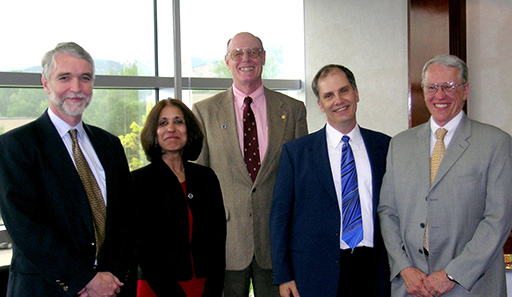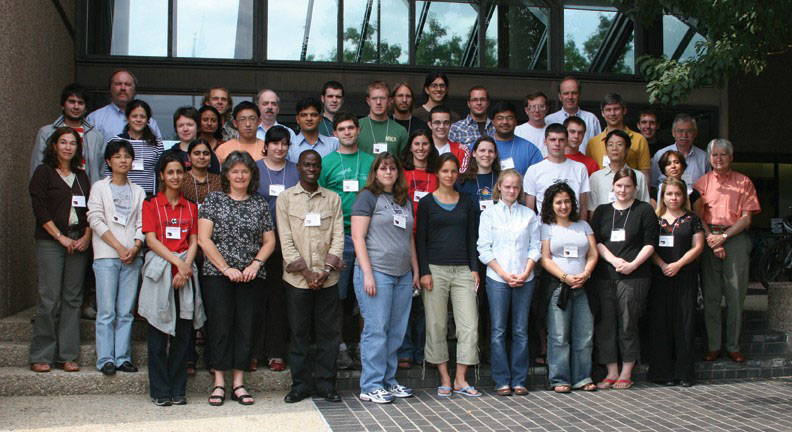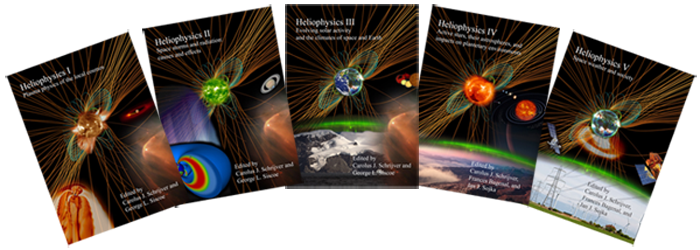How did Heliophysics Emerge?
Madhulika “Lika” Guhathakurta was wrestling with a question. It was 2005, only two years before the launch of the International Heliophysical Year program. Scientists worldwide were busy planning IHY’s efforts to advance the concept of “universal processes” through cross-disciplinary studies.
This concept — that the structure of the universe is determined by the interplay of gravity and magnetism through fundamental physical processes — excited many astronomers. These processes could be most easily observed in the realm of our own star. In fact, the Sun, solar wind, planets, magnetospheres, ionospheres and atmospheres could be viewed as elements of a single dynamic system, one that is replicated throughout the cosmos. Scientists in separate disciplines were beginning to work together to study the connections between these elements.
Guhathakurta wondered: Could these disciplines become one connected science?
Dreaming of an integrated science
This wasn’t an idle question. Guhathakurta led NASA’s Living With a Star (LWS) program, which focuses on space weather and other products of the Sun’s variability that directly affect society.
By the late 1990s, space weather was no longer of interest only to scientists. Advanced new technologies were often found to be susceptible to it, potentially at significant cost. Tom Bogdan explains how airlines relying on new Iridium satellites to fly polar routes were impacted by solar flares.
They cared about space weather because if there was a big [solar] flare, it could disrupt the Iridium satellites and their ability to get air traffic control [over polar routes], and they would have to fly south over a more traditional Alaska route. United Airlines told me they lost $100,000 per flight when they had to reschedule and go south over Alaska instead.
Tom Bogdan
Former director of UCAR
Space weather could also harm astronaut health in space and power grids on Earth. Guhathakurta and others at NASA LWS knew that space weather prediction would advance faster if the relevant areas of research were integrated.
She and her boss, Dick Fisher, director of NASA’s Sun-Earth Connections Division, had been trying to devise names for this broad solar-terrestrial science. “It had to encompass so many subdisciplines,” she says. Then NASA top brass asked Fisher to rename the division in one word. Fisher consulted with George Siscoe, a Boston University space physicist and advocate of universal processes, before proposing the name the IHY planners had already been using: “heliophysics”. Guhathakurta explains the background for choosing this word.
Now that the science had a name, NASA needed a strategy to integrate it. Guhathakurta shared her thoughts with Karel Schrijver, at the time a solar physicist at the Lockheed Martin Solar and Astrophysics Laboratory. They both knew how hard it would be to encourage scientists in hyper-focused fields to communicate.
Why not start this integration with students?
Fostering a new science through education
Since the 1970s, American solar, heliospheric and space physicists had been migrating from university campuses to federal labs, leaving fewer faculty to create educational materials for those fields.
Guhathakurta sensed a gap that NASA could help fill. It was also an opportunity to plant the seed of heliophysics in physics departments nationwide. A new science like this needed its own textbook to announce its subject matter to the world. Fisher wholeheartedly agreed.
Unfortunately, nobody had expertise broad enough to write one.
Guhathakurta was quite familiar with NCAR, the NSF-sponsored atmospheric research center, and UCAR, the NSF-sponsored university consortium that manages NCAR. She recalled the series of classical seminars that NCAR holds regularly on given topics — and a beautiful idea came to her.
She would start a seminar-style summer school for graduate and postdoctoral students, recruit faculty that were experts in their subdisciplines, and synthesize their lectures into a textbook.
Her “co-conspirators”, including Fisher, Schrijver, Jack Eddy, Tom Bogdan, and Tim Killeen — many of whom she knew from her fellowship years at the HAO — were enthusiastic about her plan. This summer school would generate a body of integrated knowledge, a community, and aids that faculty could use to build curricula for their own heliophysics courses.
Guhathakurta set to work. She saw Schrijver, the solar physicist, and Siscoe, the space physicist, as representing the “yin and yang of heliophysics”. She tapped them to be the first deans of her summer school.
Next, Guhathakurta engineered a NASA partnership with UCAR. UCAR amplifies the impact of NCAR science through programs and partnerships. Partnering with UCAR allowed scientists at NCAR to participate in the school without conflict, while also leveraging UCAR’s existing operational capabilities and infrastructure.
Guhathakurta also secured an able principal investigator in Meg Austin, director of the UCAR Visiting Scientists Program (today part of UCAR’s Cooperative Programs for the Advancement of Earth System Science, or CPAESS).

Kickoff of the joint NASA - NCAR/UCAR heliophysics effort. (L-R): Tim Killeen, director of NCAR; Lika Guhathakurta, lead program scientist of NASA Living With a Star; Ernie Hilder, director of the Space Weather Prediction Center; Tom Bogdan, senior scientist at NCAR’s HAO; and Dick Fisher, director of the NASA Heliophysics Science Division. Not pictured: Rick Anthes, director of UCAR. Credit: UCAR
A cooperative agreement was signed, and the UCAR Center Green Campus in Boulder became the summer school’s home. It was a milestone achievement for the new integrated science.
[The partnership between NASA and UCAR] has been a remarkable partnership. I think otherwise the program wouldn’t have survived this long… UCAR has been absolutely terrific to work with.
Madhulika Guhathakurta
Lead program scientist for NASA’s Living With a Star Program (2001-2016) and Heliophysics Summer School creator
Synthesizing knowledge into textbooks
The inaugural summer school, coincident with the International Heliophysical Year, was a great success. Twenty-one faculty and thirty-eight students from research centers and universities worldwide convened for eight days to explore the plasma physics of the local cosmos. Topics ranged from solar flares to magnetosphere modeling.

Inaugural Summer School faculty and students, 2007. Credit: UCAR/CPAESS
After the learning and socializing were over, Schrijver and Siscoe began to compile the first heliophysics textbook. It was a labor of translation that they would repeat in 2008 and 2009.
We created three textbooks by basically asking each teacher to give us a lecture, and a text. And then George and I sat down with these lecturers and went through, line by line, asking for explanations that other experts in other fields and students also might be able to understand. So there was a lot of editing in that.
Karel Schrijver
Solar physicist and former dean of the Heliophysics Summer School
Eventually five textbooks, moving from basic science to more applied knowledge, were produced. The series filled the gap that Guhathakurta had perceived. “The heliophysics textbooks are very valuable,” agrees Jan Sojka, a physicist and co-editor with Schrijver and Fran Bagenal of textbooks four and five. “There were no equivalent books that take these particular core disciplines [of electromagnetism and plasma physics] and apply them in space physics … there’s a common theme.” In 2019, Schrijver condensed these textbooks into a single online volume, Principles of Heliophysics, which emphasizes the influence of universal processes on habitability.

The Heliophysics textbook series published by Cambridge University Press.
Guhathakurta’s beautiful idea thrives
Things have certainly changed since 2005. A fundamental body of knowledge and a structured experience now exist to bring students into heliophysics. Solar, space and planetary scientists are building upon each other’s work. A heliophysics community has sprung up around the hundreds of Summer School alumni scattered across the world.
The Summer School continues to evolve. Since 2012, Nick Gross, a physicist at Boston University, has created practical, hands-on labs to supplement school lectures and build students’ computational modeling skills. New career panels help answer questions students may have about planning their future in science. The 2020 Summer School, fully virtual due to the coronavirus pandemic, saw the school’s first successful use of online learning.
The NASA - UCAR/CPAESS partnership has continued to grow as well. With Guhathakurta’s urging, the Jack Eddy Postdoctoral Fellowship was established in 2009. This fellowship supports early-career scientists in heliophysics by pairing them with mentors at U.S. research institutions. In 2015, the LWS Institute was formed to identify future research that could help reduce space weather impacts on technology.
The establishment of heliophysics as a connected system science has been revolutionary. Gone are the old walls between solar, heliospheric and space physics. Now multiple agencies integrate their research strategies to approach space weather and other cross-disciplinary problems; scientists of many stripes have come to an appreciation of each others’ work; and through the inspired dedication of Guhathakurta, Fisher, Siscoe, Schrijver and others, the spirit of heliophysics is being instilled in young scientists entering the field.
Hear a recent NASA Podcast with Lika on A Living History of Space Weather. Also learn more details about her professional life in an interview with the U.S. Consulate in Mumbai.
Read more: Where is heliophysics headed?




